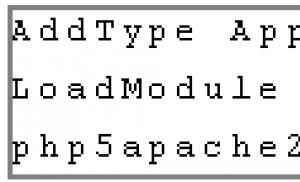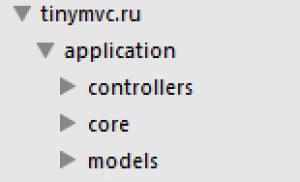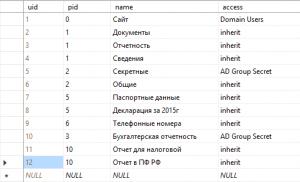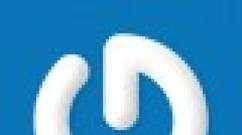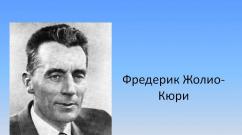Chirality of the right and left hand. Symmetry elements of molecules
Molecules that have at least one carbon atom attached to four different substituents are called asymmetric or chiral... In other words, these are molecules that have neither a center nor a plane of symmetry.
Chirality(Old Greek χειρ - hand) - the property of a molecule not to combine in space with its mirror image. The term is based on the ancient Greek name for the most recognizable chiral object - the hand. So, the left and right hands are mirror images, but they cannot be combined with each other in space.
Now we need to get acquainted with the concept of polarized light, since this phenomenon is used to study and describe chiral molecules. Light becomes plane-polarized as normal light passes through a polarizer.
If plane-polarized light is passed through a solution of a chiral substance, the plane in which the oscillations take place begins to rotate. Substances that cause this rotation are called optically active... The angle of rotation is measured with an instrument called a polarimeter (or analyzer).
The ability of any substance to rotate the plane of polarization of light is characterized by specific rotation. Specific rotation is defined as the angle of rotation of the plane of polarization with a solution containing 1 g of an optically active substance in 1 ml at a tube length of 0.1 m. the less the rotation).
If the plane of polarization rotates to the right (clockwise) of the observer, the compound is called dextrorotatory, and the specific rotation is recorded with a (+) sign. When rotating to the left (counterclockwise), the compound is called levorotatory, and the specific rotation is recorded with a (-) sign.
Let's see how optical activity is related to the molecular structure of matter. Below is a spatial view of a chiral molecule and its specular reflection:

Optical isomers (enantiomers)
At first glance, it may seem that this is the same molecule, depicted in different ways. However, if you collect models of both forms and try to combine them so that all the atoms coincide with each other, you will quickly see that this is impossible, that is, it turns out that the molecule is incompatible with its mirror image.
Thus, two chiral molecules related to each other as an object and its mirror image are not identical. These molecules (substances) are isomers called enantiomers or optical isomers... Most of the chemical and physical properties of a pair of enantiomers are identical. This applies to boiling and melting points, density, surface tension, solubility, stability and reactivity with most reagents.
The enantiomers, however, differ from each other in two respects.
1) They act differently on plane-polarized light. One enantiomer rotates the plane of polarization of light in one direction by a certain amount. The other enantiomer will rotate the plane of polarization by exactly the same amount, but in the opposite direction.

2) Enantiomers react differently with other chiral molecules, in particular with substances of natural origin formed in biological objects. For example, if one of the enantiomers is toxic, then the other may not possess this property. If one of the enantiomers is a vitamin, then the other does not have such properties. These differences in the biochemical properties of enantiomers are due to the fact that biochemical processes in a living organism are catalyzed by enzymes (enzymes). Enzymes are chiral compounds of a protein nature. In order for a compound to be biologically active, its geometry must correspond to the structure of a particular section of the enzyme.
So, to summarize:
Molecules that have no symmetry elements are called chiral. These molecules have an unusual property - the ability to rotate the plane of polarization of plane-polarized light.
Isomers whose molecules are chiral and mirror images of each other are called enantiomers.
Enantiomers have identical physical and chemical properties and differ only in the direction of rotation of the plane of polarization of light and in the nature of their interaction with other chiral substances, for example, enzymes.
Along with structural isomers, in the series of alkanes, there are spatial isomers. This can be illustrated by the example of 3-methylhexane.
The carbon atom, designated C *, is linked to four different groups. In this hydrocarbon, with the same order of bonding of atoms, the alkyl groups can be located in different ways in the space around the carbon atom C *. There are several ways to depict spatial isomers on a plane (Fig. 6.1, 6.2).
Rice. 6.1. Volumetric image using "wedges"
Rice. 6.2. Fisher projection formulas
In Figure 6.2, there is a carbon atom C * in the center, the horizontal line indicates the bond between carbon C * and the groups protruding in front of the plane of the figure, and the vertical line is between the atom C * and the groups located beyond the plane of the figure. Fischer's projections can be rotated only in the plane of the drawing and only 180 °, but not 90 ° or 270 °. These formulas represent two different compounds. They differ from each other in the same way as an object and its mirror image, or as a left and right hand. The left and right hands are two very similar objects, but it is impossible to combine them (not to put the left glove on the right hand), which means they are two different objects.
Two compounds: an object and its mirror image (I and II), incompatible with each other, are called enantiomers (from the Greek “enantio” - opposite).
The property of a compound to exist in the form of enantiomers is called chirality (from the Greek "chiros" - hand), and the compound itself is called chiral.
The 3-methylhexane molecule has no plane of symmetry and therefore can exist as enantiomers (see Fig. 6.1).
A molecule is chiral if it does not have a plane of symmetry. There are a number of structural elements that can make a molecule not identical to its mirror image. The most important of these is the chiral carbon atom.
A chiral atom or chiral center is a carbon atom bonded to four different groups and is designated C *.
A molecule in which there are two or more identical groups at a carbon atom has a plane of symmetry and, therefore, does not have chirality, since the molecule and its mirror image are identical. Such molecules are called achiral .
For example, isopentane cannot exist as enantiomers and is not chiral.
Enantiomers exhibit the same physical properties except for one. For example, a 2-bromobutane molecule exists as two enantiomers. They have the same boiling points, melting points, density, solubility, and refractive indices. One enantiomer can be distinguished from another by the sign of rotation of plane-polarized light. Enantiomers rotate the plane of polarized light by the same angle, but in different directions: one clockwise, the other at the same angle, but counterclockwise.
Enantiomers have the same chemical properties, the rate of their interaction with reagents that do not have chirality is the same. In the case of a reaction with an optically active reagent, the reaction rates of enantiomers are different. Sometimes they differ so much that the reaction of a given reagent with one of the enantiomers does not proceed at all.
Concept chirality- one of the most important in modern stereochemistry. A model is chiral if it does not have any elements of symmetry (plane, center, mirror-rotary axes), except for simple rotation axes. We call the molecule, which is described by such a model, chiral (which means "like a hand", from the Greek ... hiro- hand) for the reason that, like hands, molecules are not compatible with their mirror images. 1 shows a number of simple chiral molecules. Two facts are quite obvious: firstly, the pairs of the given molecules represent mirror reflections of each other, and secondly, these mirror reflections cannot be combined with each other. You will notice that in each case the molecule contains a carbon atom with four different substituents. Such atoms are called asymmetric. An asymmetric carbon atom is a chiral or stereogenic center. This is the most common type of chirality. If a molecule is chiral, then it can exist in two isomeric forms, related as an object and its mirror image, and incompatible in space. Such isomers (pair) are called enantiomers.
The term "chiral" is not open to interpretation. When a molecule is chiral, then, by analogy with a hand, it must be either left or right. When we call a substance or some of its sample chiral, it simply means that it (he) consists of chiral molecules; in this case, it is not at all necessary that all molecules are the same from the point of view of chirality (left-handed or right-handed, R or S, see section 1.3). Two limiting cases can be distinguished. In the first, the sample consists of molecules identical from the point of view of chirality (homochiral, only R or only S); such a sample is called enantiomerically pure... In the second (opposite) case, the sample consists of the same number of molecules different from the point of view of chirality (heterochiral, the molar ratio R: S= 1: 1); such a sample is also chiral, but racemic... There is also an intermediate case - a nonequimolar mixture of enantiomers. This mixture is called skelemic or non-racemic. Thus, the statement that a macroscopic sample (as opposed to an individual molecule) is chiral should be considered not entirely clear and therefore insufficient in some cases. Additional indication may be required as to whether the sample is racemic or non-racemic. The lack of accuracy in understanding this leads to a certain kind of misconception, for example, in the headings of articles, when the synthesis of a certain chiral compound is declared, but it remains unclear whether the author simply wants to draw attention to the very fact of the chirality of the structure discussed in the article, or the product was actually obtained in the form a single enantiomer (i.e., an ensemble of homochiral molecules; this ensemble, however, should not be called a homochiral sample). Thus, in the case of a chiral nonracemic sample, it is more correct to say "Enantiomerically enriched" or " enantiomerically pure ".
Methods for imaging optical isomers
The image method is chosen by the author solely for reasons of convenience in conveying information. In Figure 1, images of enantiomers are given using perspective images. In this case, it is customary to draw links lying in the plane of the image with a solid line; connections going beyond the plane are shown by a dotted line; and the connections directed towards the observer are shown with a bold line. This image method is quite informative for structures with one chiral center. The same molecules can be depicted in the form of a Fisher projection. This method was proposed by E. Fisher for more complex structures (in particular, carbohydrates) with two or more chiral centers.







Mirror plane
Rice. one
To construct Fisher's projection formulas, the tetrahedron is rotated so that two bonds lying in the horizontal plane are directed towards the observer, and two bonds lying in the vertical plane are directed away from the observer. Only an asymmetric atom falls on the image plane. In this case, the asymmetric atom itself, as a rule, is omitted, keeping only the crossing lines and symbols of the substituents. To remember the spatial arrangement of the substituents, a dashed vertical line is often kept in projection formulas (the upper and lower substituents are removed beyond the plane of the drawing), but this is often not done. Below are examples of different ways of depicting the same structure with a certain configuration (Fig. 2)
Fisher projection

Rice. 2
Here are some examples of Fisher's projection formulas (Fig. 3)

(+)-(L) -alanine (-) - 2-butanol (+) - ( D) -glyceric aldehyde
Rice. 3
Since the tetrahedron can be viewed from different sides, each stereoisomer can be represented by twelve (!) Different projection formulas. To standardize projection formulas, certain rules for their writing have been introduced. So, the main (nomenclature) function, if it is at the end of the chain, is usually placed at the top, the main chain is depicted vertically.
In order to compare "non-standard" written projection formulas, you need to know the following rules for transforming projection formulas.
1. The formula cannot be taken out of the plane of the drawing and cannot be rotated by 90 o, although it can be rotated in the plane of the drawing by 180 o without changing their stereochemical meaning (Fig. 4)

Rice. 4
2. Two (or any even number) permutations of substituents at one asymmetric atom do not change the stereochemical meaning of the formula (Fig. 5)

Rice. 5
3. One (or any odd number) permutation of substituents at the asymmetric center leads to the formula of the optical antipode (Fig. 6)

Rice. 6
4. Rotation in the plane of the drawing by 90 0 turns the formula into an antipodal one, unless at the same time the condition for the location of the substituents relative to the plane of the drawing is not changed, i.e. consider that now the side substituents are behind the plane of the drawing, and the upper and lower ones are in front of it. If you use a formula with a dotted line, then the changed orientation of the dotted line will directly remind you of this (Fig. 7)

Rice. 7
5. Instead of permutations, projection formulas can be transformed by rotating any three substituents clockwise or counterclockwise (Fig. 8); in this case, the fourth substituent does not change the position (such an operation is equivalent to two permutations):

Rice. eight
Fischer's projections cannot be applied to molecules whose chirality is associated not with the chiral center, but with other elements (axis, plane). In these cases, 3D images are needed.
D , L - Fisher's nomenclature
We discussed one problem - how to depict a three-dimensional structure on a plane. The choice of the method is dictated exclusively by the convenience of presentation and perception of stereo information. The next problem is related to the compilation of the name for each individual stereoisomer. The name should reflect information about the configuration of the stereogenic center. Historically, the first nomenclature for optical isomers was D, L- the nomenclature proposed by Fischer. Until the 1960s, it was more customary to designate the configuration of chiral centers on the basis of planar projections (Fisher), and not on the basis of three-dimensional 3D - formulas, while descriptors were used DandL. Currently D, L- the system is used to a limited extent - mainly for such natural compounds as amino acids, hydroxy acids and carbohydrates. Examples illustrating its application are shown in Fig. 10.

Rice. 10
For α - amino acids, the configuration is denoted by the symbol L if in the Fischer projection formula the amino (or ammonium) group is located on the left; symbol D used for the opposite enantiomer. For sugars, configuration designation is based on the orientation of the highest-numbered OH group (furthest from the carbonyl end). If OH - the group is directed to the right, then this is the configuration D; if HE is on the left - configuration L.
Fischer's system at one time made it possible to create a logical and consistent stereochemical systematics of a large number of natural compounds originating from amino acids and sugars. However, the limitations of the Fischer system, as well as the fact that an X-ray diffraction method appeared in 1951 for determining the true arrangement of groups around a chiral center, led to the creation in 1966 of a new, more rigorous and consistent system for describing stereoisomers, known as R, S - the Kahn-Ingold-Prelog (KIP) nomenclature. In the instrumentation system, special descriptors are added to the usual chemical name. R or S(in italics in the text) that strictly and unambiguously define the absolute configuration.
NomenclatureKahn-Ingold-Prelog
To define a descriptor R or S for a given chiral center, the so-called chirality rule. Consider four substituents associated with the chiral center. They should be arranged in a uniform stereochemical seniority sequence; for convenience, let's designate these substituents by the symbols A, B, D and E and agree to consider that in the general sequence of precedence (in other words, by priority) A is older than B, B is older than D, D is older than E (A> B> D> E) ... The chirality rule of the EIA requires that the model be considered from the side opposite to that occupied by the substituent E with the lowest priority or stereochemically lower substituent (Fig. 11). Then the other three substitutes form something like a tripod, the legs of which are directed at the viewer.

Rice. eleven
If the drop in the precedence of substituents in the row A> B> D is carried out clockwise (as in Fig. 11), then the center is assigned a configuration descriptor R ( from latin word rectus - right). In a different arrangement, when the stereochemical precedence of the substituents falls counterclockwise, the center is assigned a configuration descriptor S (from latin sinister - left).
By depicting connections using Fisher projections, you can easily define the configuration without building spatial models. The formula must be written so that the junior deputy is at the bottom or at the top, since according to the rules for representing Fisher's projections, vertical ties are directed from the observer (Fig. 12). If, in this case, the remaining substituents are arranged clockwise in decreasing order of precedence, the compound is referred to ( R) -series, and if counterclockwise, then k ( S) -a series, for example:

Rice. 12
If the junior group is not on vertical links, then it should be swapped with the lower group, but it should be remembered that the configuration is reversed. You can do any two permutations without changing the configuration.
Thus, the determining factor is stereochemical precedence . Let's discuss now precedence sequence rules, i.e. the rules by which groups A, B, D and E are ranked in order of priority.
Priority preference is given to atoms with a large atomic number. If the numbers are the same (in the case of isotopes), then the atom with the highest atomic mass (for example, D> H) becomes the older one. The youngest "substitute" is a lone electron pair (for example, in nitrogen). Thus, the seniority increases in the row: lonely pair
Let's consider a simple example: in bromochlorofluoromethane CHBrCIF (Fig. 13) there is one stereogenic center, and two enantiomers can be distinguished as follows. First, the substituents are ranked according to their stereochemical seniority: the higher the atomic number, the older the substituent. Therefore, in this example, Br> C1> F> H, where “>” means “more preferred” (or “older”). The next step is to look at the molecule from the side opposite to the lowest substituent, in this case hydrogen. It can be seen that the other three substituents are located at the corners of the triangle and are directed towards the observer. If the seniority in this triplet of substituents decreases clockwise, then this enantiomer is denoted as R... In a different arrangement, when the seniority of the substituents falls counterclockwise, the enantiomer is designated as S. Designations R and S write in italics and are placed in parentheses before the name of the structure. Thus, the two considered enantiomers are named ( S) -bromochlorofluoromethane and ( R) -bromochlorofluoromethane.

Rice. thirteen
2. If two, three or all four identical atoms are directly connected with an asymmetric atom, the precedence is established according to the atoms of the second belt, which are no longer connected with the chiral center, but with those atoms that had the same precedence.

Rice. 14
For example, in the molecule of 2-bromo-3-methyl-1-butanol (Fig. 14), according to the first belt, the oldest and the lowest substituents are easily determined - these are bromine and hydrogen, respectively. But according to the first atom of the CH 2 OH and CH (CH 3) 2 groups, it is not possible to establish the seniority, since in both cases it is a carbon atom. In order to determine which of the groups is older, the sequence rule is again applied, but now the atoms of the next belt are considered. Compare two sets of atoms (two triplets), written in the order of decreasing seniority. Seniority is now determined by the first point where a difference is found. Group WITH H 2 OH - oxygen, hydrogen, hydrogen WITH(OНН) or in numbers 6 ( 8 eleven). Group WITH H (CH 3) 2 - carbon, carbon, hydrogen WITH(WITH CH) or 6 ( 6 61). The first point of difference is underlined: oxygen is older than carbon (by atomic number), therefore the CH 2 OH group is older than CH (CH 3) 2. Now we can designate the configuration of the enantiomer depicted in Figure 14 as ( R).
If such a procedure did not lead to the construction of an unambiguous hierarchy, it is continued at increasing distances from the central atom, until, finally, differences are encountered, and all four substitutes receive their seniority. Moreover, any preference acquired by one or another deputy at one of the stages of seniority approval is considered final and cannot be reassessed at subsequent stages.
3. If branching points are encountered in a molecule, the procedure for establishing the precedence of atoms should be continued along the molecular chain of the highest precedence. Suppose you want to determine the order of precedence of the two substituents shown in Figure 15. Obviously, the solution will not be achieved either in the first (C) or in the second (C, C, H) or in the third (C, H, F, C, H, Br) layers. In this case, you will have to go to the fourth layer, but this should be done along the path, the advantage of which is set in the third layer (Br> F). Therefore, the decision on the priority of the deputy V over the deputy A is done on the basis that Br> CI in the fourth layer for the branch to which the transition to which is dictated by the seniority in the third layer, and not on the basis that the highest atomic number in the fourth layer is possessed by atom I (which is on the less preferred and therefore not branch under study).

Rice. 15
4. Multiple links are represented as the sum of the corresponding simple links. In accordance with this rule, each atom linked by a multiple bond is associated with an additional “phantom” atom (or atoms) of the same kind, located at the other end of the multiple bond. Complementary (additional or phantom) atoms are enclosed in parentheses and are considered not to carry any substituents in the next layer. As an example, consider the representations of the following groups (Fig. 16).
Group Representation

Rice. sixteen
5. An artificial increase in the number of substituents is also required when the substituent (ligand) is bidentate (or tri- or tetradentate), as well as when the substituent contains a cyclic or bicyclic fragment. In such cases, each branch of the cyclic structure is dissected after the branch point [where it bifurcates on its own], and the atom that is the branch point is placed (in parentheses) at the end of the chain resulting from the dissection. In Fig. 17, using the example of a tetrahydrofuran derivative (THF), the case of a bidentate (cyclic) substituent is considered. The two branches of the five-membered ring (separately) are cleaved at bonds with the chiral atom, which is then added to the end of each of the two newly formed chains. It can be seen that as a result of the dissection A a hypothetical substituent —CH 2 OCH 2 CH 2 - (C) is obtained, which turns out to be older than the real acyclic substituent —CH 2 OCH 2 CH 3 due to the advantage of the phantom (C) at the end of the first substituent. On the contrary, formed as a result of dissection V the hypothetical ligand –CH 2 CH 2 OCH 2 - (C) is lower in seniority than the real substituent –CH 2 CH 2 OCH 2 CH 3, since the latter has three hydrogen atoms attached to the terminal carbon, while the former has none in this layer. Therefore, taking into account the established order of precedence of substituents, the configuration symbol for a given enantiomer turns out to be S.
Determine seniority Deputy A
V> A
Deputy A

Fig. 17

Rice. eighteen
A similar case of dissection of the cyclic substituent is illustrated by the example of the compound in Fig. 18 where the structure V illustrates the interpretation of the cyclohexyl ring (in the structure A). In this case, the correct sequence of precedence is di- n-gesylmethyl> cyclohexyl> di- n-pentylmethyl> N.
We are now sufficiently prepared to consider a substituent such as phenyl (Fig. 19 structure A). We discussed the disclosure scheme for each multiple connection above. Since (in any Kekule structure) each of the six carbon atoms is double bonded to another carbon atom, then (in the KIP system) each carbon atom of the ring carries an additional carbon as a "substitute". The ring supplemented in this way (Fig. 19, structure V) is then expanded according to the rules for cyclic systems. As a result, the dissection is described by the scheme shown in Fig. 19, the structure WITH.

Rice. nineteen
6. We now consider chiral compounds in which the differences between substituents are not material or constitutional in nature, but are reduced to differences in configuration. Compounds containing more than one chiral center will be considered below (see Section 1.4). Here we will also touch on substituents that differ cis - trans- isomerism (olefinic type). According to Prelog and Helmchen, the olefin ligand in which the senior substituent is located on the same side from the double bond of the olefin, as the chiral center, has an advantage over the ligand in which the senior substituent is in trance–Position to the chiral center. This position has nothing to do with the classical cis-trans nor to E–Z– nomenclature for double bond configuration. Examples are shown in Figure 20.

Rice. twenty
Compounds with multiple chiral centers
If there are two chiral centers in a molecule, then, since each center can have (R)- or ( S) -configuration, the existence of four isomers is possible - RR, SS, Rs and SR:

Rice. 21
Since the molecule has only one mirror image, the enantiomer of the compound (RR) there can only be an isomer (SS). Similarly, another pair of enantiomers is formed by isomers (Rs) and (SR). If the configuration of only one asymmetric center changes, then such isomers are called diastereomers. Diastereomers are stereoisomers that are not enantiomers. So, diastereomeric pairs (RR)/(Rs), (RR)/(SR), (SS)/(Rs) and (SS)/(SR). Although in the general case, when two chiral centers are combined, four isomers are formed, the combination of centers of the same chemical structure gives only three isomers: (RR) and (SS), which are enantiomers, and (Rs), diastereomerically related to both enantiomers (RR) and (SS). A typical example is tartaric acid (Figure 22), which has only three isomers: a pair of enantiomers and meso-form.

Rice. 22
meso-Wine acid is (R, S) -isomer, which is optically inactive, since the union of two mirror-symmetric fragments leads to the appearance of a plane of symmetry (a). meso-Wine acid is an example of an achiral compound of the meso-configuration, which is built from an equal number of chiral elements that are identical in structure but different in absolute configuration.
If the molecule contains P chiral centers, the maximum number of stereoisomers can be calculated using the formula 2 n; however, sometimes the number of isomers will be less due to the presence of meso-forms.
For the names of stereoisomers of molecules containing two asymmetric carbon atoms, two substituents at each of which are the same, and the third are different, prefixes are often used erythro- and treo- from the names of the sugars erythrose and threose. These prefixes characterize the system as a whole, and not each chiral center separately. When depicting such connections using the Fischer projections in the pair erythro- isomers, the same groups are located on the same side, and if the different groups (C1 and Br in the example below) were the same, the meso-form would be obtained. Paired with treo- isomers, the same groups are located on different sides, and if the different groups were the same, the new pair would remain an enantiomeric pair.

Rice. 23
All the examples of compounds considered above have a chiral center. This center is the asymmetric carbon atom. However, other atoms (silicon, phosphorus, sulfur) can also be the center of chirality, as, for example, in methylnaphthylphenylsilane, o-anisylmethylphenylphosphine, methyl-p-tolylsulfoxide (Fig. 24)

Rice. 24
Chirality of molecules devoid of chiral centers
A necessary and sufficient condition for the chirality of a molecule is its incompatibility with its mirror image. The presence of a single (configurationally stable) chiral center in a molecule is a sufficient, but not at all necessary condition for the existence of chirality. Consider chiral molecules lacking chiral centers. Some examples are shown in Figures 25 and 26.

Rice. 25

Rice. 26
These are connections with the axes of chirality ( axial chirality): allene; alkylidenecycloalkanes; spirals; the so-called atropisomers (biphenyls and similar compounds, the chirality of which arises due to the hindered rotation around a simple bond). Another chirality element is the chirality plane ( planar chirality). Examples of such compounds are ansa compounds (in which the alicyclic ring is too small for the aromatic ring to twist through it); paracyclophanes; metallocenes. Finally, the chirality of the molecule can be associated with the helical organization of the molecular structure. The molecule can be wrapped in either a left or right spiral. In this case, one speaks of helicity (helical type of chirality).
In order to determine the configuration of a molecule with axis of chirality, it is necessary to introduce an additional item into the sequence rule: the groups closest to the observer are considered older than the groups farthest from the observer. This addition must be done, since for molecules with axial chirality, the presence of identical substituents at opposite ends of the axis is permissible. Application of this rule to the molecules depicted in Fig. 25 is shown in Fig. 27.

Rice. 27
In all cases, the molecules are viewed along the chiral axis on the left. It should be understood that if the molecules are considered from the right, then the configuration descriptor will remain the same. Thus, the spatial arrangement of the four support groups corresponds to the vertices of the virtual tetrahedron and can be represented using the corresponding projections (Fig. 27). To determine the appropriate descriptor, we use the standard rules R, S-nomenclature. In the case of biphenyls, it is important to note that substituents in the ring are considered from the center (through which the chiral axis passes) to the periphery, in violation of the standard sequence rules. So, for biphenyl in Fig. 25 correct sequence of substituents on the right ring C — OCH 3> C — H; the chlorine atom is too far removed to be taken into account. The reference atoms (those by which the configuration symbol is determined) are the same when the molecule is viewed from the right. Sometimes, to distinguish axial chirality from other types, descriptors are used aR and aS (or R a and S a), but the use of the prefix " a"Is optional.
Alternatively, molecules with axes of chirality can be considered helical, and their configuration can be denoted by the symbols R and M... In this case, to determine the configuration, only substituents with the highest priority are considered both in the front and back (remote from the observer) parts of the structure (substituents 1 and 3 in Fig. 27). If the transition from the front seat 1 with the highest priority to the priority rear seat 3 is done clockwise, then this is the configuration R; if counterclockwise is the configuration M.
In fig. 26 shows molecules with planes of chirality... It is not so easy to define the plane of chirality, and it is not as unambiguous as the definition of the center and axis of chirality. This is a plane that contains as many atoms of the molecule as possible, but not all of them. In fact, chirality is because (and only because) at least one substituent (more often more) does not lie in the chiral plane. So, the chiral plane of ansa-junction A is the plane of the benzene ring. In paracyclophane V the most substituted (lower) ring is considered as the chiral plane. In order to determine the descriptor for planar-chiral molecules, the plane is looked at from the side of the atom closest to the plane, but not lying in this plane (if there are two or more candidates, then the one that is closer to the atom with the highest priority is chosen according to the sequence rules ). This atom, sometimes called a test or pilot atom, is indicated by an arrow in Figure 26. Then, if three consecutive atoms (a, b, c) with the highest priority form a broken line curving clockwise in the chiral plane, then the configuration of the compound pR (or R p), and if the polyline is bent counterclockwise, then the configuration descriptor pS(or S p). Planar chirality, like axial chirality, can alternatively be viewed as a kind of chirality. In order to determine the direction (configuration) of the spiral, it is necessary to consider the pilot atom together with the atoms a, b and c, as defined above. From this it is clear that pR-connections correspond to R-, a pS- connections - M–Spirality.
8.2.2.b. Symmetry definition of chirality
Now let us consider the question: to what point symmetry groups should a molecule belong to be chiral? In other words, what should be the nature of the dissymmetry of the molecule, and what elements of symmetry must be absent? First of all, it is obvious that any truly asymmetric molecule belonging to the C 1 group that does not have any symmetry elements except for identity (and the C 1 axis, since C 1 E) is chiral. It is also obvious that molecules with a plane of symmetry (s) or a center of symmetry (i) are achiral, since they consist of two identical "halves" and in a mirror image the left and right halves are transformed into each other or without rotations (in the presence of a plane) , or rotated by 180 0 (if there is an inversion center). Molecules having mirror-rotary axes (S n) are also aligned with their mirror image, and therefore achiral. Therefore, only molecules belonging to the axial point groups C n and D n are chiral.
Thus, the following symmetry criterion for chirality can be formulated:
any molecule that does not have an improper rotation axis S n is chiral.
The old definition of optical isomerism, namely, "a molecule must have neither a plane nor a center of symmetry," is not precise enough. Since S 1 s and S 2 i, if a molecule does not have an improper rotation axis, then it should not have either s or i. There are molecules that have neither i nor s, but have the S n axis, and which are therefore achiral. An example is the 1,3,5,7-tetramethylcyclooctatetraene molecule (XI), which has neither a plane nor a center of symmetry, but has a mirror-rotational axis S 4. It is optically inactive.

For the first time, proof of the validity of the above definition of chiral molecules was obtained in the study of isomeric quaternary ammonium salts with a spiran nitrogen atom IV, V, VII and IX. Isomers IV and V are asymmetric (group C 1), isomer VII is dissymmetric (group D 2). Therefore, these three isomers must be chiral. Indeed, they were obtained in optically active form. However, isomer VIII belongs to the S 4 group, i.e. achiral, and it is impossible to obtain it in optically active form.
8.2.2.c. Symmetry classification rules for molecules
The molecular structure of organic compounds can be so complex that the search for possible symmetry elements is often a very difficult task. Therefore, some reasonable practical method of sequential actions is needed when classifying molecules according to point symmetry groups. Below is a diagram of the method proposed by F.Cotton in 1971.
1) First, it is necessary to determine whether the molecule belongs to one of the following groups: (СҐ v (cone symmetry), DҐ h (cylinder symmetry), I h, O h, T d (type 4, Table 8.1). These groups are conventionally We will call “special.” Note that only linear molecules belong to the CҐ v or DҐ h group, for example HC C-Cl (CҐ v), HC CH, Cl-C C-Cl (DҐ h), etc.
2) If the molecule does not belong to one of the special groups, it is necessary to look for its own rotation axis C n. Having found such an axis, we pass to operation (3). If there is no proper rotary axis, it is necessary to look for the center of symmetry i or the mirror plane s. If the molecule has an inversion center, it belongs to the point group C i, and if there is a mirror plane, it belongs to the point group C s. If a molecule has no symmetry elements (except for E), it belongs to the C 1 group.
3) Next, we find main axis With n, i.e. the axis with the largest n-value. Determine if there is a mirror-rotary axis S 2n coinciding with the main axis. If it exists, and there are no other elements, except, possibly, i, the molecule belongs to one of the groups S n, where n is an even number. If the S 2n axis is there, but there are other elements, or if the S 2n element is absent, it is necessary to go to operation (4).
4) We are looking for a set of n second-order axes lying in a plane perpendicular to C n. If such a set is found, the molecule belongs to one of the groups D n, D nh or D nd. Then we go to operation (5). If there are no such axes, the molecule belongs to the C n, or C nh, or C nv group. Then we go to operation (6).
5) If a molecule has a plane of symmetry s h, perpendicular to the main axis, it belongs to the D nh group. If there is no such element, it is necessary to look for a set of n diagonal planes s d (i.e., planes of symmetry in which the main axis is located, but none of the perpendicular second-order axes lies). If both s d and s h are absent, the molecule belongs to the D n group.
6) If a molecule has s h, it belongs to the point group C nh. If s h is absent, you need to look for a set of n planes s v (passing through the main axis). The presence of such planes allows the molecule to be assigned to the C nv group. If the molecule has neither s v nor s h, it belongs to the point group C n.
The described method is illustrated by the diagram shown in Scheme 8.1.
8.2.2.y. Chirality types


Adamantanes, whose tertiary carbon atoms have four different substituents, are chiral and optically active; for example, compound XIII has been resolved into enantiomers. When comparing formulas XII and XIII, it is easy to see that the symmetry of both compounds is very similar. The backbone of adamantane can be thought of as a tetrahedron with "broken edges"; it has the T d symmetry, which transforms into C 1 when all four substituents on the tertiary carbon atoms are different. The adamantane derivative XIII does not have an asymmetric carbon atom, as in a-bromopropionic acid, but has a center inside the molecule (the center of gravity of unsubstituted adamantane). Asymmetric center is a special case of a more general concept chiral center... A chiral center can have not only asymmetric molecules, but also molecules of symmetry C n or D n. In the examples below, the chiral center is marked with an asterisk.

The chiral center is only one of the possible elements of chirality. Molecules whose chirality is due to the presence of a chiral center are by far the most important in organic chemistry. However, in addition to the central one, there are also axial, planar and spiral types of chirality.
Molecules with a chiral axis possess axial chirality. Chiral axis it is easy to obtain by mentally "stretching" the center of chirality:

The chiral axis is possessed by such classes of molecules as allene and biphenyls. In allens, the central sp-type carbon has two mutually perpendicular p-orbitals, each of which overlaps with the p-orbital of the neighboring carbon atom, as a result of which the remaining bonds of the terminal carbon atoms are located in perpendicular planes. Allene itself is chiral, since it has a mirror-rotational axis S 4, but asymmetrically substituted alleles of the type abC = C = Cav are chiral.

Allenes are chiral only if both terminal carbon atoms are substituted asymmetrically:
For any odd number of cumulated double bonds, the four end groups are no longer located in different, but in the same plane, for example, for 1,2,3-butatriene:

Such molecules are achiral, but cis-trans isomerism is observed for them.
Thus, compound XIV was separated into optical isomers.

If one or both double bonds of a symmetrically substituted allene are replaced by a cyclic system, then the resulting molecules will also have axial chirality, for example:

In biphenyls containing four bulky groups in ortho-positions, free rotation around the central bond is hindered due to steric hindrances, and therefore the two benzene rings do not lie in the same plane. By analogy with allene, if one or both benzene rings are symmetrically substituted, the molecule is achiral; chiral molecules with only two asymmetrically substituted rings, for example:

Isomers that can be separated only because rotation around a single bond is difficult are called atropisomers.
Sometimes, three or even two bulky substituents in the ortho positions are sufficient to prevent free rotation in biphenyls. Thus, it was possible to separate biphenyl-2,2-disulfonic acid (XV) into enantiomers. In compound XVI, free rotation is not completely inhibited, and although it can be obtained in optically active form, upon dissolution in ethanol it rapidly racemizes (half in 9 minutes at 25 0).

For some chiral molecules, the defining structural element is not the center, not the axis, but the plane. The simplest model planar chirality easy to construct from any plane figure that does not have axes of symmetry lying in this plane, and a separate point outside the plane. The best studied planar-chiral derivatives of ferrocene (XVII). Other examples are chromium tricarbonyl arene complexes (XVIII) as well as compounds XIX and XX.

Helical chirality is due to the helical shape of the molecule. The spiral can be twisted left or right, giving enantiomeric spirals. For example, in hexagelicene, one part of the molecule is forced to be located above the other due to spatial obstacles.

8.2.2.d. Chirality of macrocyclic molecules
Macrocycles containing several dozen atoms connected in a ring are capable of forming amazing types of molecular structures with left- or right-handed helicity.
For example, in compound XXI, the main chain has the form of a Mobius strip, which must exist in two enantiomeric forms. Compound XXI was synthesized and indeed turned out to be chiral.

Loops of 60 or more members can exist as knots (XXII) tied from left to right or from right to left, and therefore must be chiral.

The appropriately substituted catenanes and rotaxanes can also be chiral. These compounds consist of two or more independent parts that are not connected by valence bonds, but nevertheless are held together. Catenans are built of two or more loops connected like chain links; in rotaxanes, a linear molecule is threaded through a cyclic molecule and cannot escape from it due to the presence of bulky end groups.

Catenanes and rotaxanes can be obtained either by statistical synthesis or directed synthesis. The principle of statistical synthesis is illustrated by the following diagram.

Compound A binds at two ends to compound B in the presence of a huge excess of macrocyclic compound C. Before the reaction with molecules B, some part of A molecules must accidentally be threaded through cycle C, and therefore, along with products D and E, a certain amount of rotaxane D is formed. Examples are given below.


Chiral catenans and rotaxanes have not yet been obtained.
Course work on the topic
“Chirality, possible mechanisms of its origin. The role of chirality in the aging process ”
Performed:
fourth year student
Faculty of Bioengineering
and bioinformatics
Moscow State University M.V. Lomonosov
Gancharova Olga Sergeevna
I. Introduction. The concept of chirality. Chirality in nature
The overwhelming majority of any complex molecules containing more than three atoms do not have a plane or a center of symmetry. Such molecules are dissymmetric and chiral. The term "chirality" (from the ancient Greek heir - hand, compare surgery, palmistry) means the non-coincidence of some structure with its mirror image. Chiral substances can appear in two forms - right and left. These two configurations cannot be combined with each other by any rotation of the system as a whole in space, they relate to each other, like the right and left hands
In the world of molecules, chirality is most often encountered, determined by the so-called asymmetric carbon atom (usually marked with an asterisk, see p. 36). In saturated (aliphatic) organic compounds, the four valence bonds of carbon are located at tetrahedral angles to each other. If two out of four valencies bind the same groups, as, for example, in the CX2YZ molecule, then the CYZ plane is the symmetry plane and there is no chirality. A carbon atom is asymmetric if all four groups it is associated with are different — C * XYZV. Such a molecule does not have a pi plane or a center of symmetry. Thus, chirality is inherent in 19 canonical amino acids (all except glycine H3N + CH2C00-). In fig. 2.11 shows the right (D) and left (L) configurations of alanine (mirror antipodes or enantiomers).
In chemical synthesis, a substance is always obtained from the original symmetric molecules in the form of a racemic mixture containing 50% each of the right and left antipodes. This follows from the second law of thermodynamics - the racemate corresponds to the maximum entropy.
An amazing property of living nature is the fixation in organisms of all the most important biological molecules, starting with amino acids, in one definite configuration. Amino acid residues in proteins are always "left", L-forms (Fig. 2.11).
The right and left forms react in the same way with symmetric molecules. They differ in their interaction with polarized light. Chiral substances, in contrast to their racemic mixtures, rotate the plane of polarization of light in different directions and differently absorb light that is circularly polarized to the right and to the left (see Chapter 6). Biological L-amino acids are not so named because they rotate the plane of polarization of light to the left, and D-amino acids - to the right. Among the L-amino acids, there are both left and dextrorotatory. The starting point for the L-series of organic compounds is the levorotatory glyceraldehyde OCH-C * H (OH) - CH20H. All L-compounds can, in principle, be obtained from it by replacing the corresponding atoms and groups attached to C *, without changing the general configuration of the molecule.
Chirality is inherent in proteins, carbohydrates, nucleic acids, and a number of low molecular weight compounds in the cell. Carbohydrates in DNA and RNA always appear in the D-form. Nitrogenous bases are flat and therefore lacking in chirality. In metabolic processes that occur without racemization, that is, without the transformation of mirror antipodes into each other, the cell assimilates only those of them that correspond to the structures of its biological molecules. The body metabolizes L- but not D-amino acids. Once in the "antiworld", in which plants and animals contain molecules with opposite configurations, the earthly organism would die of hunger. For the body, D- and L-antipodes are different. There are known substances that are poisonous in one form and harmless in a mirror form; L-aspartic acid is tasteless, its antipode is sweet. Even Pasteur established that some bacteria feed mainly on one antipode of a given substance.
Isolation of pure antipodes in vitro from racemic mixtures (asymmetric synthesis) is carried out using chiral substances of biological origin (usually alkaloids). Acting on the racemic mixture (D, L) with compound L ', we obtain (D, L) + L' = DL '+ LL' Compounds DL "and LL 'are no longer mirror antipodes (they would be DL" and LD "). Therefore, the physicochemical properties of DL 'and LL' are different, and these compounds can be separated, for example, by crystallization.
To separate the antipodes, an asymmetric effect of a substance or a being that knows the difference between right and left is necessary. Mirror antipodes were discovered by Pasteur in 1848. He studied tartaric acid and found that it has right and left crystal forms. By sorting them, Pasteur obtained pure antipodes of tartaric acid. He played the role of an asymmetric factor - a person himself is "chiral" and knows the difference between right and left. Chirality exists in living nature both at the molecular level and at the higher levels of organizations. It is ultimately determined by the "chiral" regulation of enzymatic processes. In fig. 2.12 shows two forms of the shell of the rhizome of Neogloboquadrina packyderma. Clockwise shells form at temperatures below 7 ° C, counterclockwise shells form at higher temperatures.
In nature, chirality can be molecular or crystalline. In the first case, it is preserved - during the melting or dissolution of a substance (for example, sugar), in the second - it is characteristic only of the crystalline state. Quartz is built from symmetric SiO2 molecules, but crystallizes in right-handed or left-handed forms with opposite optical activity. When quartz melts, optical activity disappears. In any deposit, the number of right-handed and left-handed crystals is on average the same. Accordingly, it is possible to isolate a pure antipode by crystallization by placing a non-racemic right or left seed in the racemic mixture.
So, in living nature there is a fixation in biological structures of any one form of chiral substances (for example, in DNA and RNA, there is always a D-form of carbohydrates). From the point of view of biophysics, this is explained by the fixation of information, that is, the selective antipode is equivalent to information in 1 bit.
